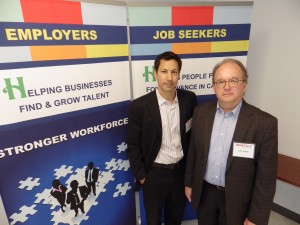The WorkPlace seeks to link jobs, training
In the next two months, a national work-strategy company ”” FutureWorks ”” will provide the state Department of Labor with data in both numbers and meetings-gathered anecdotes designed to prevent southwestern Connecticut from fighting the last employment battles as new economies arise.
Joseph Carbone, president and CEO of Bridgeport-based The WorkPlace, recently told a room of 50 at Sacred Heart University”™s Stamford campus at Landmark Square that an ongoing challenge is to structure plans that have job seekers and employers working in tandem, with mutual benefits.
“It”™s not always easy to do,” he said. “But there are those moments.
“There”™s no question this Great Recession has changed things,” he said. “What”™s changed is the whole practice of how employers package for human capital. They have options they previously didn”™t have.”
Carbone cited one business model as “the old way,” saying: “Demand was up so you hired. What I”™m hearing now is you don”™t hire as demand increases. You often have other tools.”
Those tools include a rise in both staffing agencies and part-time workers.
“We don”™t carry a big stick,” Carbone said. “We can”™t make our partners do what they don”™t want to do. We need regional consensus.”
Calling himself “a free-market guy,” Carbone nonetheless criticized businesses who constantly post to job boards, pretending they are actively looking to fill positions when in reality they are keeping a hook in the water for top talent 24/7.
Stamford Mayor David Martin attended, saying he was both interested and late to the dance: “I”™m going to change some responsibilities in my office,” he said. “I have no one on my staff now with a sense of responsibility for jobs and workforce alignment.”
Darien First Selectman Jayme Stevenson and Easton First Selectman Adam Dunsby attended, as did business representatives including Alejandra Hochstedtler-Stipo, principal of Bridgeport-based Stamford Clinical Services LLC, a career coaching, recruiting and consulting firm, and Stamford resident and job seeker Carolyn Jenkins, who was looking to translate careers in radiology and film into something new.
The WorkPlace had already sponsored a series of informational meetings with FutureWorks on subeconomies like manufacturing, retail and health care as part of what it calls its “multiyear effort to plan programs for employers and job seekers in southwestern Connecticut.” A report to the state Department of Labor is expected in June or July.
FutureWorks was represented by vice presidents Stephen Michon and John Hoops. They reported on federal Bureau of Labor Statistics findings from a worker survey of 1,000 businesses that received 170 responses. They said audience input was critical to their research.
Michon”™s and Hoops”™ data showed educational demand underpins the large job shifts coming. In 1973, they reported, 72 percent of the U.S. job market was filled by those with a high school degree or less. That metric by 2020 will be 26 percent. Those with bachelor”™s degrees held 9 percent of jobs in 1973; by 2020 that number will be 24 percent.
Among FutureWorks”™ early findings: southwestern Connecticut is increasingly greater in minority population and the jobs being created regionally pay less than old white-collar standbys like management. Meanwhile, the region”™s finance/insurance sector ”” long an upward-skewing data point for regional pay with its six- and seven-figure paychecks ”” is slowly receding.
Even as it accounts for $16 billion in annual pay in Fairfield County, the financial/insurance services sector with its average $248,000 annual pay ””the biggest sector by far in terms of money, doubling manufacturing”™s total pay of $8 billion at No. 2 ”” lost 7 percent of its jobs countywide between 2010 and 2014. Sectors like information technology, management, wholesale/distribution and health care ”” all termed “high-wage industries” ”” grew between 7 percent and 9 percent.
The biggest job growth in numbers in the last four years has been in the relatively low-paying accommodation/food service sector, which grew regionally 21 percent, followed by the arts-recreation-entertainment sector”™s 16 percent growth.
Those lower-wage jobs have an increasing number of people working two jobs regionally. The survey found those earning other incomes outside their primary jobs ”” 56,665 in 2001 ”” was 89,309 in 2014.
Yet even as lower-paying jobs multiply, education levels to obtain them go up. The FutureWorks survey found regionally that 76 percent of respondents hired high school graduates; that number will fall to 57 percent in three years.
FutureWorks is separately investigating similar data for the Department of Commerce and the Aspen Institute across multiple U.S. municipalities, but The WorkPlace had already hired the firm seeking the same answers first.
FutureWorks cites its mission as helping design strategies, inform policies, and build institutions that promote sustainable, skill-based regional economic growth and competitiveness.
FutureWorks”™ central office is in New York City, with associate offices in Massachusetts, where Michon works, and New Hampshire, home to Hoops”™ office.
